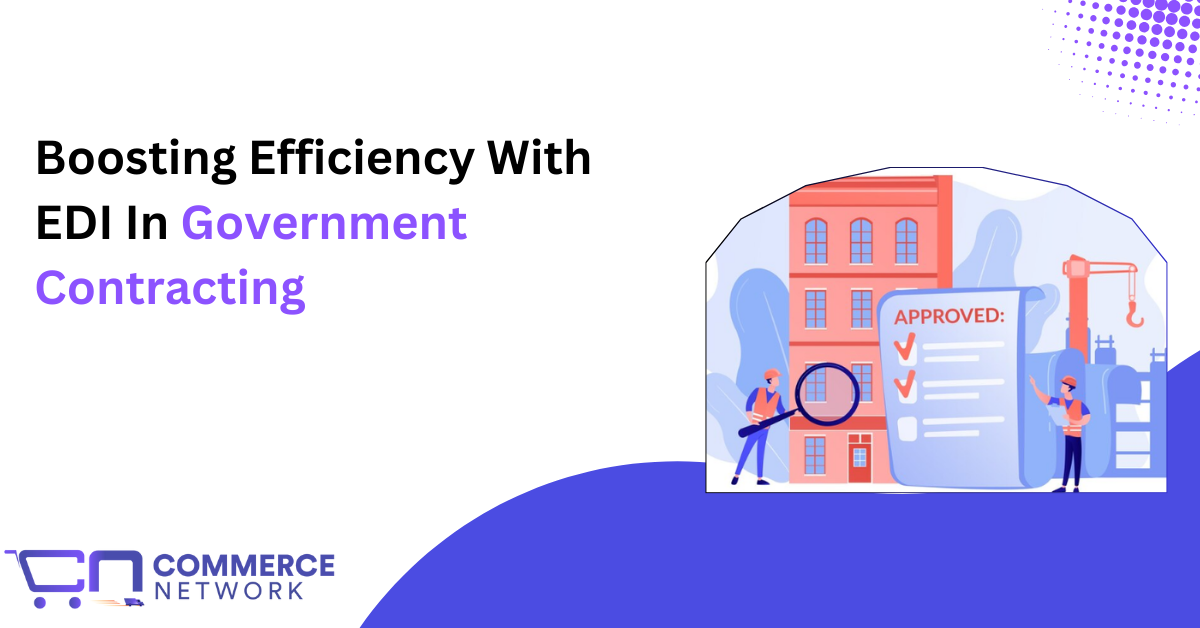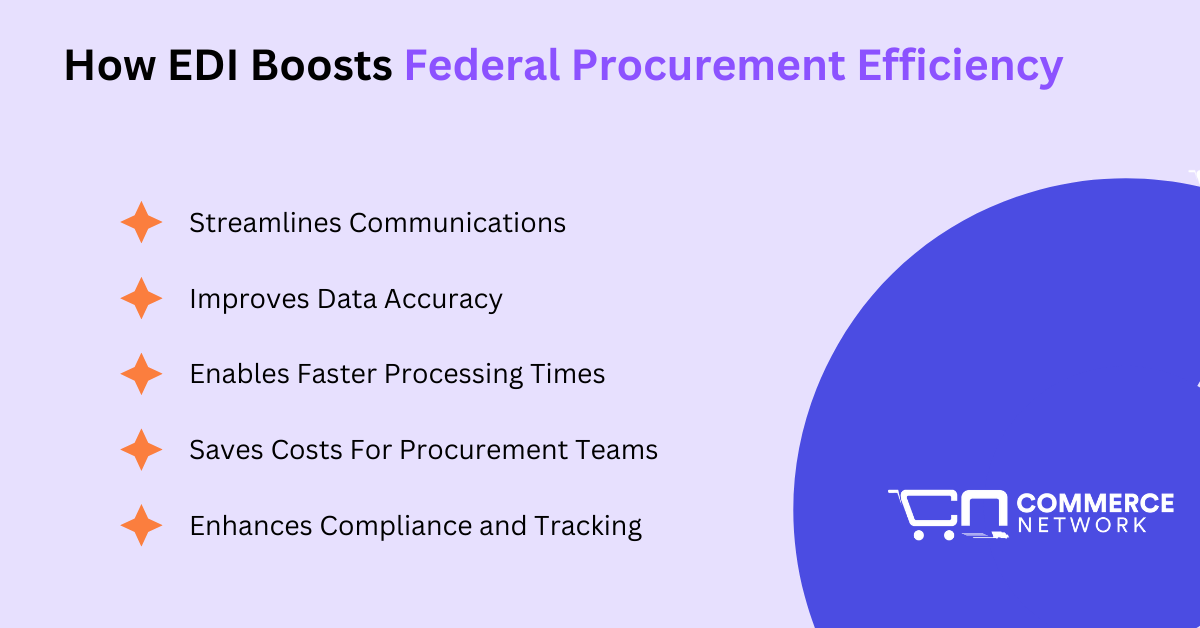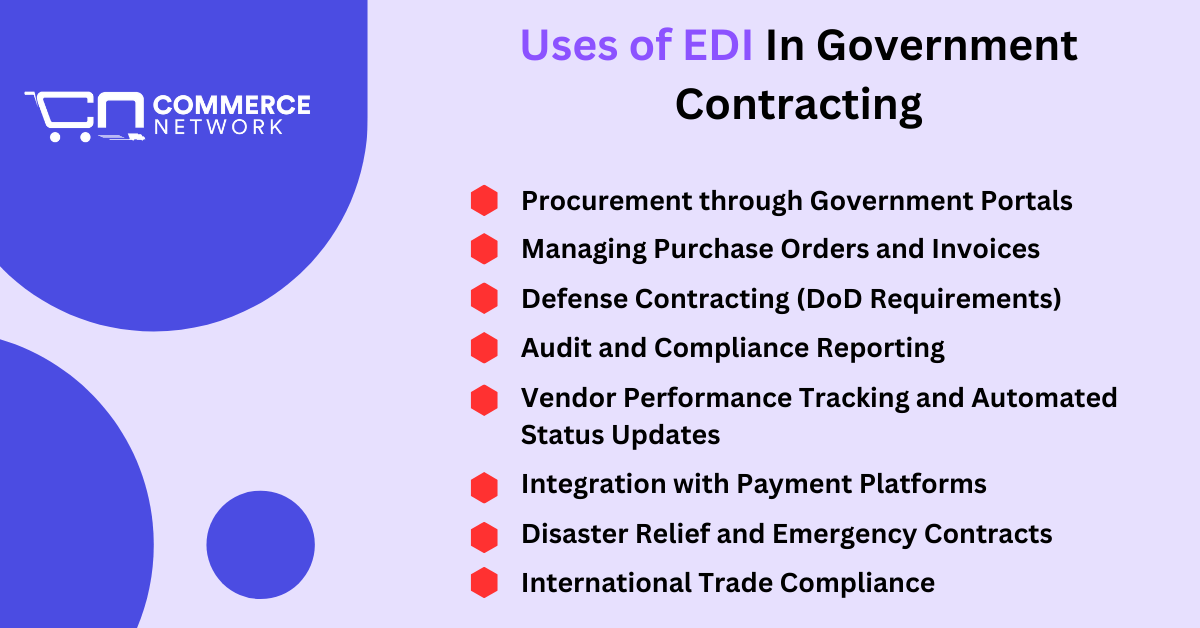By Bipin Dhungana | December 23, 2024

Electronic Data Interchange (EDI) traces its governmental roots back to the 1940s with the military using it for cargo operations. And since the 1960s, EDI has been widely used in many industries.
The US government, being one of the early adopters of EDI has seen the effectiveness of this technology. So now, EDI is used in wide-scale government and military procurement operations, document exchange between agencies, and communication with contractors.
This article explains what EDI is, how it is being adopted, how it boosts efficiency, its benefits, challenges, and more to give a complete picture of its relation in the government contracting space.
EDI (Electronic Data Interchange) is a document exchange process that is performed electronically between two computer systems.
Traditionally, documents used to be exchanged with paper mails, faxes, and phone communications where one person talks on the phone and another notes it down.
EDI eliminated this process entirely by standardizing the document exchange process so that all the documents could electronically and automatically be exchanged between two or more organizations.
The EDI technology uses standard formats (e.g. X12, EDIFACT, TRADACOMS, etc.) established by organizations like ANSI (American National Scientific Institute) and UN (United Nations) that are recognized by all businesses, government agencies, and individuals to transmit documents between trading partners in a supply chain network.
So now, most documents like Purchase Orders, Shipping Notices, Invoices, etc. exchanged in B2B (Business to Business) and B2G (Business To Government) use EDI instead of emails, faxes, paper mail, or other communication methods.
Managing transactions with tens of thousands of vendors with millions of supplies, products, and procurement items requires a sustainable and effective technology to not cause errors, disruptions, delays, and the like.
EDI, which requires extremely little manual labor, automates data exchange, order fulfillment, transactions, and payment processing.
This way, government contractors and public agencies buying from these contractors can effectively communicate about purchase orders, shipping statuses, invoices, and payment processing.
Moreover, EDI also helps with inventory management, product catalog management, data analysis, and reporting for the vendors dealing with the government. This makes EDI a very important tool in government contracting.
Thousands of government agencies dealing with millions of transactions daily need EDI-capable vendors to manage the transactions effectively. They also need EDI to communicate with other agencies and maintain compliance.
So, it is not hard to imagine that without the use of EDI, pretty soon the procurement system of the government as well as communication between government agencies will come to a grinding halt.
In essence, EDI has become a must-have feature for government contractors and public agencies dealing with procurement, B2B, and B2G transactions.
Take an example of a federal agency that wants office furniture (let us say chairs) for 20 of its offices. It can either go for open procurement or through GSA to get the required chairs from a vendor.
Here, the agency would have to first generate an order of purchase for the chairs in 20 offices (let us say 200 chairs total). Then, the agency needs to track the shipment and delivery status of those chairs, and generate and confirm invoices and payment, all the while constantly communicating with the vendor.
Suppose the federal agency and vendor use traditional methods like emails and faxes to communicate and manual data entry to update their stock inventory and ERP systems. In that case, they will find that the process is cumbersome, ineffective, and more likely to encounter errors at any point between order generation and eventual delivery.
Now imagine the same case for the agency requiring 50 different types of items, each with large quantities from tens of different suppliers. It becomes extremely difficult to manage all these without EDI.
Here is how EDI actually helps boost efficiency in federal procurement.

EDI ensures quick, accurate, and streamlined communications between vendors and public agencies through the automation of data exchanges, error reduction, and delays compared to manual processes.
Example: A federal agency uses EDI to send purchase orders directly to a supplier’s system. This eliminates the need for emails or faxes, ensuring instant delivery and confirmation of orders.
By eliminating manual data entry, EDI significantly reduces errors in procurement documents like purchase orders and invoices.
Example: An EDI-enabled system validates invoice details (e.g., item codes, quantities) against purchase orders before submission, preventing discrepancies like duplicate or incorrect entries.
By automating workflows with EDI, contractors and agencies handle real-time data transmission. EDI also enables speedy approvals as data processing gets done quickly.
Orders and payment cycles are reduced as invoices are sent and received through EDI between vendors and agencies.
Example: An EDI-enabled system validates invoice details (e.g., item codes, quantities) against purchase orders before submission, preventing discrepancies like duplicate or incorrect entries.
Federal procurement agencies and teams can minimize operational expenses on paperwork, storage, and labor costs using Electronic Data Interchange.
It is one of the most critical ways of boosting efficiency as the saved costs can now be used for more resource acquisition, increased salaries, etc.
Example: By replacing printed procurement documents with EDI, a government contractor saves thousands annually on paper, printing, and courier expenses.
Compliance matters in government contracting as many agencies have specific regulations and general compliance standards that need to be met by the agency operation department.
EDI makes sure that procurement data aligns with regulatory standards and provides audit trails for improved transparency and accountability.
Example: A federal agency uses EDI to ensure all procurement transactions comply with FAR (Federal Acquisition Regulation) standards while maintaining an automated log for auditing purposes.

EDI has many use cases where government contractors and agencies use EDI for different purposes.
Here are some cases where the use of EDI becomes very important and not using EDI can cause several problems.
Government marketplaces and procurement portals like GSA Advantage and FedMall are where public agencies go to find the products they need.
If you are a supplier trying to be a government vendor, you need to register your products on these platforms. The government agency that requires your product will then choose and buy from your catalog, just like on an online marketplace like Amazon.
EDI is used in these procurement portals for uploading product catalogs, receiving purchase orders, submitting invoices, etc.
Without using EDI, vendors cannot list products on these platforms, order processing encounters manual errors leading to rejected submissions and delayed approvals, and non-compliance risk increases.
Federal agencies most often use EDI for issuing Purchase Orders (EDI 850) and Invoices (EDI 810).
EDI makes receiving and fulfilling orders easy with reduced manual processing and helps ensure that invoices meet government formatting or compliance requirements, enabling faster payments.
As discussed before, the military was the first to use EDI. Nowadays, most DoD contractors are required to be EDI capable to even be eligible for a military contract.
EDI is used in managing supply chains, fulfilling military orders, and billing while ensuring transparency and security in military contracting.
Vendors without EDI are excluded from military procurement as systems like FedMall mandate EDI for communication.
Supply chain disruption can also occur without EDI which leads to mismatched or delayed information exchange which is a big problem when dealing with sensitive matters like military operations.
Audits are a big component of government contracting. Using EDI helps get real-time transaction records as well as historical transaction data that can be provided for audits and reporting.
Without EDI, some transaction records among thousands of transactions can easily go missing or incomplete. This makes the compliance audits challenging, leading to penalties or contract suspension.
Moreover, maintaining audit trails manually across multitudes of trading partners in a supply chain involving tens of thousands of transactions and millions of dollars can be a huge administrative burden.
Agencies use EDI to track order status, inventory, delivery timelines, and shipment details from the Advance Ship Notice (EDI 856).
EDI helps the agencies get real-time visibility data into shipment and enables a transparent supply chain operation.
Along with agencies, EDI also helps vendors adhere to performance benchmarks like specific delivery times, appropriate product quantity, pricing alignments, etc.
To reduce the long payment cycles that inconvenience both the vendors and agencies, EDI is used for invoice exchange (EDI 810).
EDI is used to submit payment requests and receive remittance advice. Using EDI also makes vendors lessen the risk of losing contracts failing to adhere to electronic payment mandates.
FEMA, Red Cross, and other disaster relief public organizations use EDI to quickly process bulk orders for emergency supplies. Faster bulk order processing helps in the delivery of critical goods like medical supplies and equipment in disaster-prone areas.
Without EDI, organizations and governments are likely to encounter bottlenecks due to manual processing during high-pressure scenarios.
One country’s document exchange method may not be usable for another country. So, using traditional exchanges is sure to create confusion, administrative hurdles, and delays in cross-border transactions.
EDI, with standardized document formats like ANSI X12 and EDIFACT, helps governments perform document exchanges in custom declarations, import/export documentation, etc.
This ensures a supplier’s goods are not held at costumes, disrupting project timelines, and makes all parties in compliance with international trade regulations mitigating fines or penalties.

While adopting EDI for government contracting is a massive boost in efficiency and is mandated more often than not, several issues need careful consideration before a government contractor uses EDI.
Federal procurement systems often involve legacy platforms with limited compatibility with modern EDI solutions. Custom middleware or APIs are often required to bridge the gap. This increases the complexity of integrations and may discourage contractors from adopting EDI.
Small businesses and government contractors face a significant barrier when adopting EDI. This is because the initial cost to implement EDI is high. One has to invest in hardware, software, and expertise.
You can significantly decrease this investment by using EDI providers like Commerce Network who bring decades of EDI experience, have partnerships with major suppliers, are comfortable with government agencies and their EDI regulations, and can handle all your EDI needs while you focus on business.
The use of multiple EDI standards like ANSI X12, EDIFACT, and TRADACOMS, may cause confusion among agencies and vendors. Contractors and procurement officials may struggle with differing standards and maintain compliance.
Different standards also equate to additional mapping, translation, integration features, functionalities, costs, and efforts.
Sensitive transactions involving government agencies and the military require secure channels, risk mitigation factors as well as firewalls and encryptions.
Agencies are required to implement robust security technologies, and vendors also need to make sure the communication channel is secure.
Compliance with security protocols is a major deterrence factor preventing many from efficient EDI adoption.
Transitioning to EDI requires staff training to understand new workflows, error management, and document tracking.
A major challenge is the resistance to change and skill gaps which can slow down adoption and disrupt operations for the government contractors and agencies.
Government procurement often involves high transaction volumes.
Scaling EDI systems to handle spikes in transaction loads, especially during fiscal year-end procurements, can strain existing infrastructure.
EDI transforms government contracting by streamlining procurement, enhancing data accuracy, and ensuring compliance with federal standards.
Despite initial challenges like integration and cost, the long-term benefits of faster processing, cost savings, and improved transparency makes EDI indispensable for modernizing federal operations. By adopting EDI, agencies and contractors can foster efficiency, accountability, and stronger partnerships in public sector procurement.
Improve Your B2B, B2G, and B2C Ecommerce?
Integrate EDI For Efficiency, Compliance, and Scalability?
Just Curious About EDI?
Give Us A Call
202-280-7060